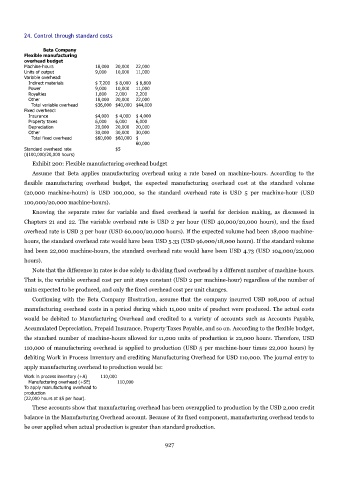Page 926 - Accounting Principles (A Business Perspective)
P. 926
24. Control through standard costs
Beta Company
Flexible manufacturing
overhead budget
Machine-hours 18,000 20,000 22,000
Units of output 9,000 10,000 11,000
Variable overhead:
Indirect materials $ 7,200 $ 8,000 $ 8,800
Power 9,000 10,000 11,000
Royalties 1,800 2,000 2,200
Other 18,000 20,000 22,000
Total variable overhead $36,000 $40,000 $44,000
Fixed overhead:
Insurance $4,000 $ 4,000 $ 4,000
Property taxes 6,000 6,000 6,000
Depreciation 20,000 20,000 20,000
Other 30,000 30,000 30,000
Total fixed overhead $60,000 $60,000 $
60,000
Standard overhead rate $5
($100,000/20,000 hours)
Exhibit 200: Flexible manufacturing overhead budget
Assume that Beta applies manufacturing overhead using a rate based on machine-hours. According to the
flexible manufacturing overhead budget, the expected manufacturing overhead cost at the standard volume
(20,000 machine-hours) is USD 100,000, so the standard overhead rate is USD 5 per machine-hour (USD
100,000/20,000 machine-hours).
Knowing the separate rates for variable and fixed overhead is useful for decision making, as discussed in
Chapters 21 and 22. The variable overhead rate is USD 2 per hour (USD 40,000/20,000 hours), and the fixed
overhead rate is USD 3 per hour (USD 60,000/20,000 hours). If the expected volume had been 18,000 machine-
hours, the standard overhead rate would have been USD 5.33 (USD 96,000/18,000 hours). If the standard volume
had been 22,000 machine-hours, the standard overhead rate would have been USD 4.73 (USD 104,000/22,000
hours).
Note that the difference in rates is due solely to dividing fixed overhead by a different number of machine-hours.
That is, the variable overhead cost per unit stays constant (USD 2 per machine-hour) regardless of the number of
units expected to be produced, and only the fixed overhead cost per unit changes.
Continuing with the Beta Company illustration, assume that the company incurred USD 108,000 of actual
manufacturing overhead costs in a period during which 11,000 units of product were produced. The actual costs
would be debited to Manufacturing Overhead and credited to a variety of accounts such as Accounts Payable,
Accumulated Depreciation, Prepaid Insurance, Property Taxes Payable, and so on. According to the flexible budget,
the standard number of machine-hours allowed for 11,000 units of production is 22,000 hours. Therefore, USD
110,000 of manufacturing overhead is applied to production (USD 5 per machine-hour times 22,000 hours) by
debiting Work in Process Inventory and crediting Manufacturing Overhead for USD 110,000. The journal entry to
apply manufacturing overhead to production would be:
Work in process inventory (+A) 110,000
Manufacturing overhead (+SE) 110,000
To apply manufacturing overhead to
production
(22,000 hours at $5 per hour).
These accounts show that manufacturing overhead has been overapplied to production by the USD 2,000 credit
balance in the Manufacturing Overhead account. Because of its fixed component, manufacturing overhead tends to
be over applied when actual production is greater than standard production.
927

